- Author: Christine Casey
The horticulture industry continues to develop new plants for home gardens, which keeps gardeners coming back for more plants every year. While traits such as disease resistance or tolerance of difficult soil are appreciated, the key feature for new plants is often a wow factor: large flowers, unusual shapes or colors, or multiple layers of petals. Not unlike the tail fins on cars of the Fifties, however, these characteristics may just be for show and may add little horticultural value.
And while these features may sell plants, they often are to the detriment of bees. Multiple layers of petals can make it difficult for bees to find the pollen and nectar resources that they need. And in some cases, these fancier, more complex flowers may not provide forage value at all. A British study comparing single-flowered varieties of common garden flowers to newer double-flowered varieties of the same plant found that, in three of the four species studied, the double flowers had little or no nectar (Corbet et al., 2001, Annals of Botany, 87:219-232).
So when selecting plants for your bee garden, keep it simple.

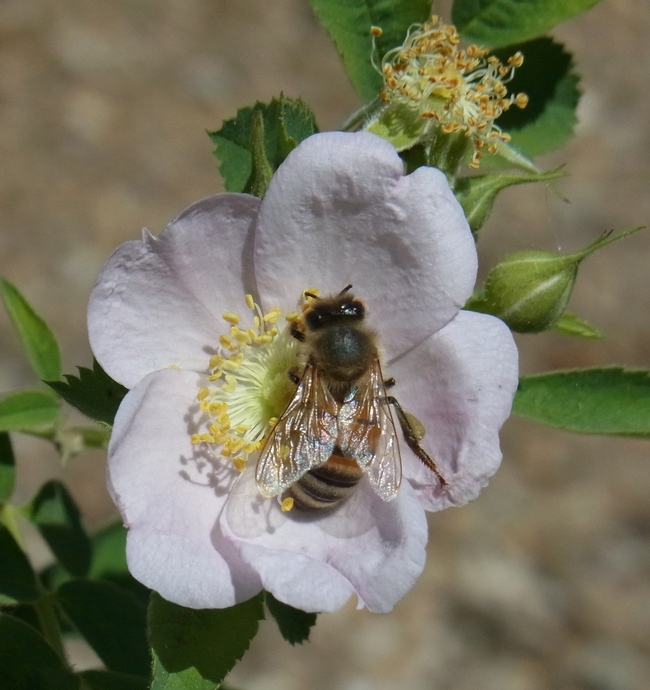


- Author: Christine Casey
To mark National Pollinator Week, June 16-22, 2014, join us for an open house at the Honey Bee Haven on Friday, June 20, from 5:30 to 7pm.
Here's your chance to talk to experts about bees and bee gardens; all visitors will take home a free pack of zinnia seeds while they last. Our best heat-tolerant and water-wise bee plants will be in bloom so this will be a great opportunity to learn more about buckwheats, salvias, yarrows, and other bee plants that thrive in our hot, dry summer weather.
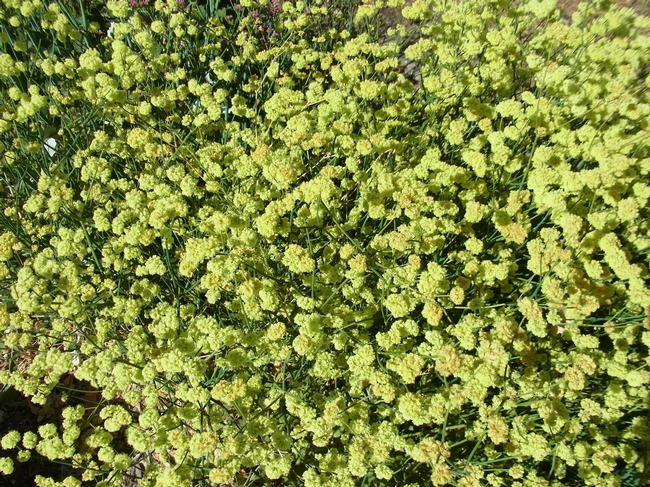

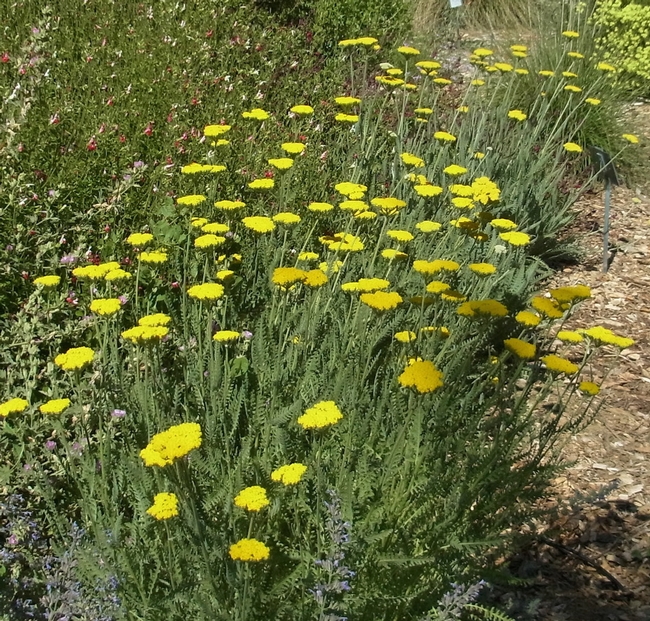
The garden is located on Bee Biology Road near the campus airport. From Hutchison Drive, take Hopkins and make the first right onto Bee Biology Road; the garden is at the end of the road. Please see the attached flyer for more information.
Pollinator Week flyer
- Author: Christine Casey
“How many plants do I need?” “How should I space my plants?” are two of the common questions we hear at the Honey Bee Haven when visitors ask about designing their bee gardens. Among the factors ecologists use to evaluate how bees use a floral resource are patch size, floral diversity, and floral density.
Patch size is the area covered by the desired resource (flowering plants) in a habitat that is fragmented. Floral diversity is the number of different species of flowering plants in an area, while floral density is the number of flowering plants in an area.
For honey bees, patch size is key. The scout bees return to the hive and direct their sisters to a good resource. Honey bees are efficient foragers that will visit many flowers on one plant until they have a full load of pollen or nectar. By grouping all plants of a species into a singe patch rather than spreading them around the garden you help honey bees maximize the value of each trip to and from the hive. There is no hard and fast rule for a minimum patch size, although three feet square is an area often recommended by bee biologists.
Bumble bees, on the other hand, tend to move quickly from plant to plant. So large patches of one plant species are less important than dense patches with a diversity of flowering plants.
At the Haven we have examples of both planting styles.
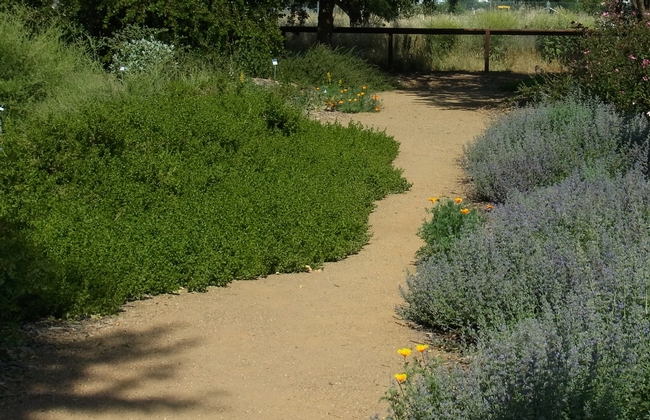

Getting back to the questions posed at the beginning of the post: rather than worrying that you might not have a large enough garden or be able to provide the right mix of plants, just do it! Choose plants that will provide flowers for as much of the year as possible, with as much of the garden as you can planted with flowers. In the Davis area, bees are active year round so the Haven always has something in bloom. If the garden does include turf areas, which don't provide bee forage or habitat, try to plant your flowers so that they are in a continuous patch.
- Author: Christine Casey
Tremendous thanks go to the California State Society Daughters of the American Revolution for their generous support of the Haven. At a festive lunch held at the garden on Friday, March 28, State Regent Debra Jamison presented me with a check for $15,000 to support the addition of benches, shade structures, improved wheelchair access, and additional bee habitat at the garden.
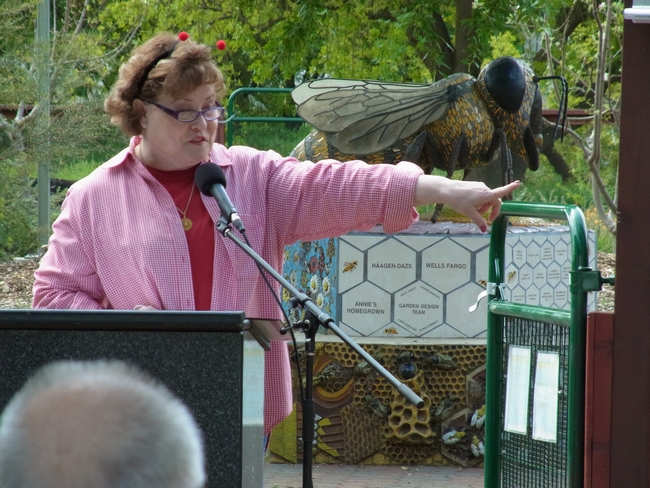

Benches: two benches have been placed in garden and are already being well-used. Additional seating will be added as space and funds permit.
Shade structures: one large structure (12 feet by 25 feet) will be located at the entrance to Grower's Grove. The structure will provide a comfortable place for tour groups to stand and interact with their docent. The structure will support numerous bee-friendly vines.
Smaller arbors will be placed over the benches to provide shady spots for sitting. Again, bee-friendly vines such as honeysuckle, wisteria, passionflower, and wild grape will ensure both shade for visitors and habitat for bees.
Wheelchair access: The Haven has always been an accessible facility, but I'm interested in ways to make it easier for all visitors to enjoy and learn. Our planter boxes are being raised to wheelchair height, 24 inches, to facilitate observation of the bees in the crops planted there.
Bee habitat: Plant nerds like me can always find room for more plants! More importantly, the greater the variety of plants we showcase means more options and inspiration for our visitors' own bee gardens. New habitats include dry shade and moist shade areas as well as updates to My Back Yard. 
- Author: Christine Casey
On Saturday, March 14, the California Center for Urban Horticulture (CCUH) sponsored a Pollinator Gardening Workshop as part of their Sustainable Backyard series. Co-sponsors were the UC Davis Department of Entomology and Nematology and the UC Davis Arboretum. Over 100 participants attended on a beautiful day that was perfect for viewing both pollinators and plants.
Along with me, entomologists on the program were Robbin Thorp, Neal Williams, and Eric Mussen. Participants learned about both wild bees and honey bees, their importance to our food supply, and UC Davis bee research. Providing for bees in urban gardens and how this is done at the Häagen-Dazs Honey Bee Haven were also discussed.
Ellen Zagory, Director of Horticulture at the UC Davis Arboretum, spoke about her favorite bee plants and presented design ideas for successional bloom.
In the afternoon, workshop attendees had the opportunity to see these ideas in practice. After visiting the Haven, where Robbin and I answered questions, participants could head to the Arboretum plant sale for a “workshop only” hour of sales.
If you weren't able to make it, the good news is that the presentations will be available on the CCUH web site. Other Arboretum plant sale dates this spring are April 5, April 26, and May 17.
And mark your calendars for May 9, National Public Gardens Day. There will be an open house at the Haven from 5:30 to 7 that evening, with a garden tour at 6.







